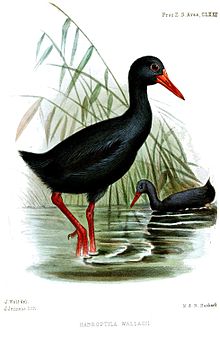| Invisible rail | |
|---|---|

| |
| Adult by Joseph Wolf, 1859 | |
| Scientific classification | |
| Domain: | Eukaryota |
| Kingdom: | Animalia |
| Phylum: | Chordata |
| Class: | Aves |
| Order: | Gruiformes |
| Family: | Rallidae |
| Genus: | Habroptila Gray, GR, 1861 |
| Species: | H. wallacii
|
| Binomial name | |
| Habroptila wallacii Gray, GR, 1861
| |

| |
Recent records Inset shows location of Halmahera within Indonesia
pre-1950 records Kao town | |
| Synonyms | |
|
Gallirallus wallacii | |
The invisible rail, Wallace's rail, or drummer rail (Habroptila wallacii) is a large flightless rail that is endemic to the island of Halmahera in Northern Maluku, Indonesia, where it inhabits impenetrable sago swamps adjacent to forests. Its plumage is predominantly dark slate-grey, and the bare skin around its eyes, the long, thick bill, and the legs are all bright red. Its call is a low drumming sound which is accompanied by wing-beating. The difficulty of seeing this shy bird in its dense habitat means that information on its behaviour is limited.
Recorded dietary items include sago shoots and insects, and it also swallows small stones to help break up its food. It is apparently monogamous, but little else is known of its courtship behaviour. The only known nest was a shallow bowl in the top of a rotting tree stump that was lined with wood chips and dry leaves. The two young chicks were entirely covered in black down typical of precocial newly hatched rails. The estimated population of 3,500–15,000 birds and the restricted range mean that the invisible rail is classified as vulnerable by the International Union for Conservation of Nature (IUCN). Habitat loss has occurred through the harvesting of sago and conversion of the wetlands to rice cultivation, and the rail is eaten by local people. The described nest was in an area frequented by local villagers, so the rail may be more adaptable to habitat changes than had been thought.
- ^ "Habroptila wallacii". IUCN Red List of Threatened Species. 2016. BirdLife International: e.T22692781A93369321. 2016. doi:10.2305/IUCN.UK.2016-3.RLTS.T22692781A93369321.en. Retrieved 19 November 2021.
